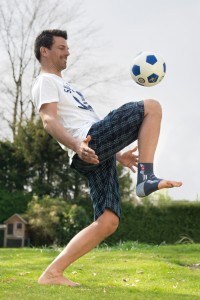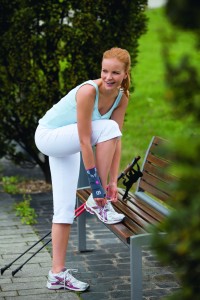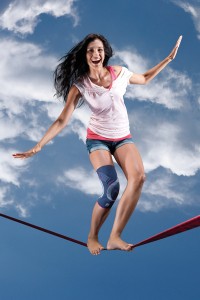As part of mediֳ 20% off sale on PhysioRoom.com, we looked at five common injuries which can be sustained during everyday activities, with advice on how to recover from them and products which can help your rehabilitation process.
Sprained Ankle
Even if youֶe never experienced any of the other injuries in this article, itֳ likely that you֬l be familiar with a sprained ankle. Itֳ a common problem caused simply when the ankle moves out of its normal position, twisting inwards (an inversion injury) or outwards (an eversion injury) and causing soft tissue damage.
There are three different grades of ankle sprains, depending on how severely you have injured it:
- First degree: Damage to a few ligament fibres
- Second degree: More extensive damage to the ligament, with swelling
- Third degree: A complete rupture of the ligament, with swelling and potentially a joint dislocation
As is normal with injuries involving swelling, the first job is to reduce the inflammation with ice and rest the ankle. Try and avoid walking if possible, and use a plastic cast when out and about for protection. For worse ankle sprains, an x-ray and hospital treatment is necessary.
During the rehabilitation process for a sprained ankle, it can be very useful to wear an ankle support, particularly as itֳ common for sprains to reoccur due to the instability caused by the initial problem.
The Levamed Ankle Brace is silicone padded and includes a tension strap, both of which simultaneously compress and gently massage the joint. This keeps the ankle feeling secure, which is one of the most important factors in maintaining balance and positioning while recovering from your injury.
Repeatedly sprained ankles can cause a deep-rooted weakness, which could require surgery.
Whiplash
Whiplash refers to a neck injury caused by a sudden movement of the head, and is commonly associated with car accidents due to the sudden impact experienced. The damage will usually depend on the nature of the collision:
- In a head-on collision, the head and neck will continue to move forward while the body stops suddenly, stretching the ligaments and muscles at the back of the neck.
- A rear-end collision will cause the head and neck to be thrown backwards and so the front of the neck will be stretched.
Neck pain and stiffness gradually increase after suffering whiplash and usually reach its worst point the day after the incident. Other after-effects can include headaches, dizziness and hearing problems.
After consulting a doctor, the first port of call is usually to wear a soft collar around the neck. This is to help the ligaments and muscles in the neck by removing the strain of the weight of the head.
The Hereford Collar features a mouldable form to allow adjustment, and uses polystyrene pressure beads which spread evenly across the neck to prevent sores.
Prescribed pain relief will then follow and ongoing physiotherapy treatment can be given for serious cases.
Tennis Elbow
Donִ be fooled by the name Рthis condition doesnִ just affect the professionals. In fact, tennis elbow can be caused by a variety of sports, common pastimes and everyday activities. It can occur from weight-lifting or canoeing, from playing certain musical instruments or hammering, or even from digging in the garden or driving.
Itֳ easily identifiable, too. The elbow is painful when touched and also when held straight while the hand is moved at the wrist. Gripping activities will worsen the pain.
An inflammatory condition, tennis elbow is initially treated by relevant medication, and ice packs make for a simple but effective treatment. To reduce the strain and allow the swelling to go down, itֳ recommended that you rest the area for around two weeks.
If youֲe an active person who will find it difficult to avoid activities which could aggravate the area, itֳ a good idea to wear a supportive elbow strap.
The Epicomed Elbow Support is specially designed for such an injury and features a textured silicone supporting pad system, which works by applying pressure to gently massage the affected area.
L eft untreated, longstanding cases of tennis elbow Рwhere the pain has been present for more than six months Рcan lead to a chronic tendon problem which will be much more difficult to treat.
eft untreated, longstanding cases of tennis elbow Рwhere the pain has been present for more than six months Рcan lead to a chronic tendon problem which will be much more difficult to treat.
Carpal Tunnel Syndrome
In a lot of carpal tunnel syndrome cases, itֳ not possible to work out a specific cause. However, repetitive activities involving wrist movement Рplaying sport, operating vibrating tools and machinery, and even playing computer games Рcan all contribute to such an injury.
The carpal tunnel is the gap in the carpal bones in the wrist. Muscles, blood vessels and nerves all pass through this gap on their way to the hand from the forearm. Carpal tunnel syndrome essentially refers to the swelling caused within this small gap.
On top of the pain in the wrist, hand or thumb, burning, tingling and numbness can occur.
To help with the issue, itֳ recommended that you take a break even from straightforward activities involving your wrist, like typing. Wrist supports can help significantly in relieving symptoms as they prevent the movements which cause the pressure in carpal tunnel syndrome to increase.
The Manumed Active does just this Рpreventing excess stress from being placed on the wrist and providing a defensive layer of shock absorption. Its other advantages are that it is lightweight and breathable to wear.
Severe carpal tunnel syndrome pain can be treated with ice packs, anti-inflammatory drugs or corticosteroid injections.
Strengthening exercises can be used during rehabilitation, and if your job involves the kind of activities which could have contributed to your injury, it is advised that you take regular breaks to prevent overloading in the wrist tissues.
It might not sound like an everyday injury, yet this knee problem can occur while youֲe running, sitting for long periods, or walking down the stairs.
The pain at the front of the knee is a frequent symptom of patellofemoral maltracking. This refers to the direction of the kneecap (aka the patella) when the knee is bent or straightened. Usually it glides along a special groove on the thigh bone (the patellofemoral groove) but the maltracking refers to when the kneecap strays from this path. This puts abnormal stress on the under-surface of the kneecap.
Physiotherapy can play a huge role in treating patellofemoral pain syndrome, while ice packs can be used to relieve the pain. The rehabilitation process includes stretching particular muscles, and wearing a knee brace can help a repeat of the issue˩n the future.
The Genumedi PT Knee Brace is specially designed for this exact problem. It stabilises the joint without feeling uncomfortable, with a patella tension strap encasing the kneecap to keep it protected.
medi currently offer this knee brace with a free theraband as well as a knee joints information brochure.


